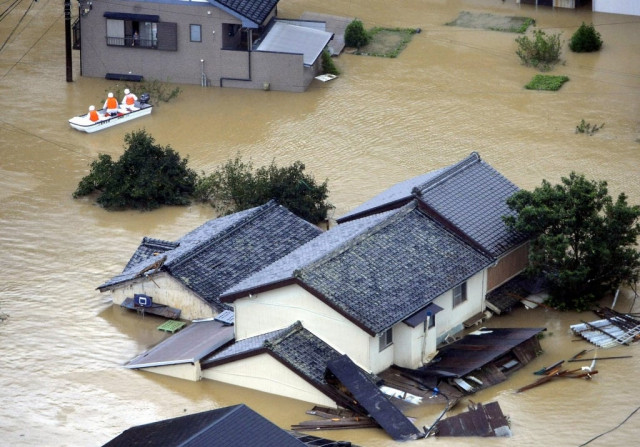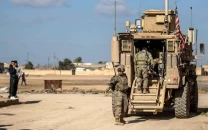Typhoon hit Japan tells 291,000 households to evacuate
At least 65 people were injured and more than 860 houses flooded.

File photo of a houses submerged in flood water in western Japan on September 4, 2011. PHOTO: REUTERS
The typhoon made landfall in Toyohashi, Aichi prefecture, shortly before 8:00 am local time, packing gusts of up to 162 kilometres per hour, the Japan Meteorological Agency said.
Public broadcaster NHK said four people were missing due to landslides or floods, while at least 65 people were injured and more than 860 houses flooded.
The typhoon was moving north-northeast at a speed of 55 kmh, with the eye of the storm passing within 50 kilometres north of the capital at around noon.
The meteorological agency issued the highest alert for "possibly unprecedented heavy rain" in Kyoto and neighbouring prefectures, while Kyoto and other local authorities advised a total of some 291,000 households to evacuate.
Television footage showed the banks of the Katsura river in the ancient capital's scenic tourist area of Arashiyama overflowing and inundating nearby hotels and souvenir shops.
Rescue workers and hotel employees were towing a small rowboat with four tourists on board in knee-deep water.
The Kyoto prefectural government requested the Self-Defence Forces to deploy troops to join sandbagging and rescue operations.
In Saitama prefecture, north of Tokyo, strong winds ripped off roofs and overturned cars.
The typhoon was expected to hit the northeast, including the Fukushima area, on Monday afternoon possibly bringing heavy rain to areas near the crippled nuclear power plant.
Operators at the plant said they were on alert amid fears the storm could result in more contaminated water running out to sea. Workers were pumping out water from areas near tanks storing radioactive water, from which leaks are believed to have seeped into groundwater.
"We are on alert for the possible impact of the typhoon at the plant, while pumping out water from areas near the tanks as rain continues intermittently," said Shogo Fukuda, a spokesman for Tokyo Electric Power (TEPCO).
"But so far we have not had major troubles at the plant." Around 300 tonnes of mildly contaminated groundwater is entering the ocean every day having passed under the reactors, according to TEPCO.
About 500 domestic flights scheduled for Monday, a public holiday, were cancelled, mainly those departing Tokyo, NHK reported.
Railway companies temporarily suspended services on many lines in central and eastern Japan, including the Shinkansen bullet trains between Shizuoka and Mishima.



1701351241-1/Afghan-refugees-(3)1701351241-1-208x130.webp)















COMMENTS
Comments are moderated and generally will be posted if they are on-topic and not abusive.
For more information, please see our Comments FAQ